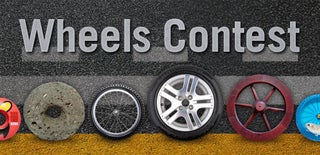Introduction: 130 MPG BICYCLE
I live about 10 miles away from my job which meant I was using about a gallon of gas a day just to get to and from work. I figured there had to be a better way. I looked at electric bikes and conversion kits but the cost was way more than I wanted to pay. Then there was the 49cc 2-stroke conversion kits. I found these as cheap as $140 but wasn't really sold on the idea of altering the bike so much. Then I remembered the "Stinger" from my childhood. These were friction drives we bolted to the back of our bikes. I started doing a little searching and found friction bikes of all kinds on YouTube. These were various motors mounted to the back of the bike with a peg on the output shaft making constant contact with the tire. This meant that every time you stopped the bike you would have to restart the motor. If something happened to the motor you would have to get off and adjust a turnbuckle to ride the bike normally. I wanted to ride the bike powered or un-powered at any time and not have to restart the motor every time I stopped. So after watching countless videos I came up with my own idea. I would incorporate some kind of clutch system in my friction bike. Presented here is what I came up with. Unfortunately I failed to take pictures during the build so I only have pictures from the finished project. By the time you finish this instructable you should have a good enough understanding of the concept to build one yourself. If you already have a bike and a motor and do some salvaging you should be able to complete this for around $50. Here is what I used:
GMC Denali 700c Road Bike
26cc Weed Wacker Motor
Schwinn Seat Tube Bike Rike
1 x Sunlite ATB Shift/Brake Lever Set - 1 Pair, 3x7-speed, 2 to 1, Black
1 x Tektro RX 4.1 Reverse Brake Levers Black
Bell Shift Cable Kit
1/2" Aluminum "U" Channel
1/8" x 1" Aluminum Flat Bar
Misc. Nuts, Bolts, and Spacer (I used all stainless steel but you can you what you have}
1/2" Plywood (A piece of scrap)
Spring
Cable Clamp (Salvaged from another bike)
Turnbuckle
Drill
Saw
Wrenches
Tape Measure
Step 1: Mounting the Motor
Before mounting the motor I cut away the parts of the plastic casing that I didn't want. Next I attached a bike axle peg to the crankshaft. The way to do this depends on the motor you are using. For mine I threaded the the end of the shaft with my tap and die set. I then slipped the peg over the shaft and used a nut and a nylon lock nut to hold it in place. Once you decide on how to attach your bike peg you must make a way to mount it to the bike. Using a piece of cardboard as a pattern, I designed a swing arm, that I cut from 1/2" plywood. I have included the pattern I designed. I then mounted the motor to the swing arm then attached the swing arm to the bike rack mounting bracket. I used a long bolt and a spacer, made from a piece of copper pipe, to align the arm to the wheel. This swing arm system will allow the motor to be moved on and off the wheel by using a lever on the handle bars. In the next step we will mount the rear support system.
Step 2: Rear Support System
The front mounting point is not enough to hold the motor inline by itself so I created a rear support system. I started by cutting 1/2" aluminum "U"-channel to length, one for each side. There is a dog ear over the rear axel on most bikes used for attaching a fender. I used this as my bottom mounting point. For the top I drilled a hole in the rack and used a long bolt and a spacer to hold it in place. The spacers are used to hold the channel vertical. This will keep the swing arm in the same plane as the wheel and keep the bike peg at a 90 degree angel to the tire. I did the same on the other side mainly to strengthen the rack. Next I made a retainer, using 1/8" x 1" aluminum flat bar, to keep the swing arm aligned. I cut each bar to length and attached one to each side of the rear of the swing arm surrounding the channel. These must be tight enough to keep the motor aligned but loose enough to allow it to move up and down. The next step is to install the spring that will lift the motor when you stop. This is nothing more than drilling a small hole in the "U"-channel, slipping the hook of the spring through it, then drill a small hole in the retaining arm and hooking the other end of the spring through it. In the next step we will install the lever and cable to pull the motor down on the tire and the throttle lever and cable.
Step 3: Installing Cables and Control Levers
When I first built this bike I used brake levers I cannibalized from an old bike for the controls. They worked but the dropped handle bars were hurting my back and I had to ride with my hands close to the stem. That made control at higher speeds a little scary at times. I can hit over 30 mph going down hill. To alleviate this problem I went to an old style handle bar (from the same bike I took the brake parts from) but that had problems as well. The original twist shifters would only go so far onto the bar which left very little room for my hand. Getting to the brake levers was dangerous as well not to mention the fact that they were not secure on the bars. While my bike was rideable, I did't feel it was real safe. I decided to blow the budget and purchased a set of integrated brake/shift levers and a set of inverted brake levers. I have linked to these in the intro and the cost for all with shipping was about $38. I can not stress how much safer these have made my bike. The shift/brake levers will be used for exactly that, brakes and shifting. The inverted brake levers will control the clutch system and throttle. To mount the clutch cable I used a cable stay off of a caliper brake and mounted it to the side of the "U"-channel. I then mounted a turnbuckle to the bottom of the swing arm and then, using the cable clamp from the caliper brake, I attached the cable to the other end of the turnbuckle. The rest is zip tying the cable to the frame. The throttle is a little more complicated. Because of the added cable, the spring on the carburetor may not be able to return to the idle position. I used the original throttle cable because it was easy to hook up to the carburetor. The free end of the cable casing had to be secured to the frame so it would not move. I used a regular hose clamp to hold this in place. Then using a piece of copper wire I attached the original throttle cable to the brake cable running to the throttle lever on the handle bars. It will take a bit of experimenting and adjusting to get the casing in the right place to get a full pull on the throttle. Next step is to test the controls and go for a ride.
Step 4: Get Ready to Ride!
Now that everything is hooked up it's time to gas up and go. To start your bike follow the start up procedures for you motor. This is usually just pressing the primer bulb a couple of times. When your ready start riding as usual. When you hit 5-7 mph squeeze your clutch lever to pull the motor against the wheel. Squeeze the throttle lever and your motor should start. Release your clutch lever and let your motor warm up about 30 seconds. Slowly apply the throttle and squeeze the clutch lever fully. Continue applying throttle and let your speed build up. You can get up to speed fasted by peddling if you like. If the peg starts to slip on the tire simply reduce the throttle until the peg engages again and slowly reapply throttle. Controlling slippage is the hardest thing about riding on a friction bike. If you are not careful you can burn through a tire pretty quick. If your careful though a tire will last a long time, I have over 800 miles on my current tire, and still going. I ride this bike to work daily (unless it is raining*) and instead of using a gallon a day I buy a gallon about every 3 weeks. I had a lot of fun building this and even more fun riding it. No matter where I go someone will always ask me about my bike.
If you don't mind being bored for 8 minutes be sure to check out my video. It covers all the modifications of this bike so far.
More Mods To Come!
I have a four stroke motor I plan on swapping onto this bike. This should give me a little more low end torque and a little more friendly to the environment. I am also working on an electric bike, using and old Hover Round style scooter, so stay tuned.
I hope everyone enjoyed this structable and maybe got inspired to build their own gas saver.
*A friction bike will not work in the rain or if the tire gets wet. So avoid those puddles!
I am sure some of you noticed I removed the second gas tank. It started leaking so I had to remove it.

Participated in the
Epilog Challenge VI

Participated in the
Great Outdoors Contest

Participated in the
Summer #mikehacks Contest

Participated in the
Metal Contest

Participated in the
Wheels Contest













